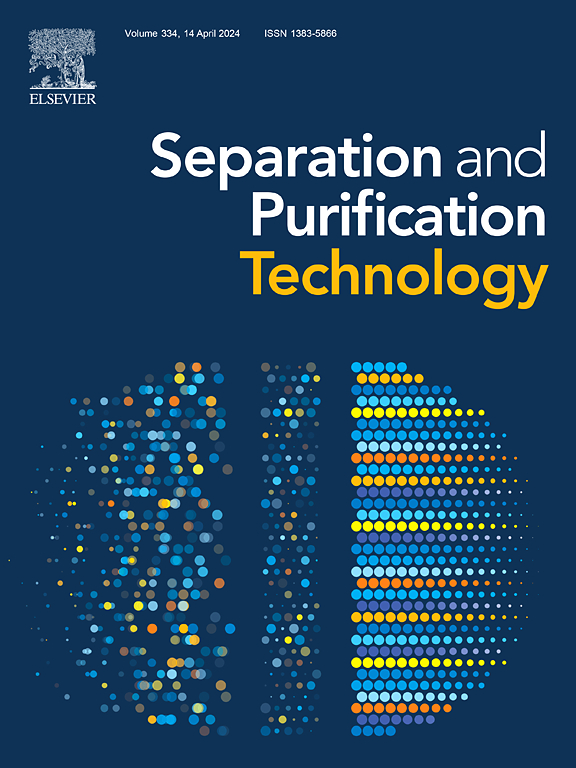钻井废水浮选过程中絮泡作用的影响因素及机理研究
IF 8.1
1区 工程技术
Q1 ENGINEERING, CHEMICAL
引用次数: 0
摘要
钻井废水日益增加的环境负担需要更高效、更机械的处理策略,以支持油气作业的可持续发展。本研究系统比较了聚氯化铝(PAC)、聚硅酸铁铝(PSAF)和硫酸铝(Al2(SO4)3)三种絮凝剂在钻井废水絮凝-浮选处理中的性能,重点阐述了絮凝-气泡作用机理。浮选试验结果表明,在1.0 g/L时,PAC对悬浮固体(SS)的去除率最高(80.58 %),其次为PSAF和Al2(SO4)3。综合表征,包括FTIR、zeta电位、接触角分析和絮凝体尺寸测量,表明PAC形成了大的、中等疏水性的絮凝体,具有较强的结构完整性和稳定的气泡粘附。相比之下,Al2(SO4)3生成的絮凝体较小,高度疏水,界面能垒低,导致团聚体稳定性差。应用EDLVO理论计算了相互作用能分布,证明了絮凝气泡粘附受范德华、静电和疏水相互作用的综合影响。PAC表现出最平衡的轮廓,结合了高粘附潜力和强附着后稳定性。这些发现为优化复杂废水系统中的絮凝-浮选工艺提供了新的机理见解,为实际工程应用提供了理论基础。本文章由计算机程序翻译,如有差异,请以英文原文为准。

Study on influence factors and mechanism of Floc-Bubble interaction in the flotation treatment of drilling wastewater
The increasing environmental burden of drilling wastewater calls for more efficient and mechanistically informed treatment strategies to support the sustainable development of oil and gas operations. This study systematically compares the performance of three flocculants—polyaluminum chloride (PAC), polyaluminum ferric silicate (PSAF), and aluminum sulfate (Al2(SO4)3)—in the flocculation-flotation treatment of drilling wastewater, with an emphasis on elucidating floc–bubble interaction mechanisms. Flotation experiments demonstrated that PAC achieved the highest suspended solids (SS) removal efficiency (80.58 % at 1.0 g/L), followed by PSAF and Al2(SO4)3. Comprehensive characterization, including FTIR, zeta potential, contact angle analysis, and floc size measurement, revealed that PAC formed large, moderately hydrophobic flocs with strong structural integrity and stable bubble adhesion. In contrast, Al2(SO4)3 generated smaller, highly hydrophobic flocs with low interfacial energy barriers, leading to poor aggregate stability. The EDLVO theory was applied to calculate interaction energy profiles, demonstrating that floc–bubble adhesion is governed by the combined effects of van der Waals, electrostatic, and hydrophobic interactions. PAC presented the most balanced profile, combining high adhesion potential with strong post-attachment stability. These findings provide novel mechanistic insights for optimizing flocculation-flotation processes in complex wastewater systems, offering a theoretical basis for practical engineering applications.
求助全文
通过发布文献求助,成功后即可免费获取论文全文。
去求助
来源期刊

Separation and Purification Technology
工程技术-工程:化工
CiteScore
14.00
自引率
12.80%
发文量
2347
审稿时长
43 days
期刊介绍:
Separation and Purification Technology is a premier journal committed to sharing innovative methods for separation and purification in chemical and environmental engineering, encompassing both homogeneous solutions and heterogeneous mixtures. Our scope includes the separation and/or purification of liquids, vapors, and gases, as well as carbon capture and separation techniques. However, it's important to note that methods solely intended for analytical purposes are not within the scope of the journal. Additionally, disciplines such as soil science, polymer science, and metallurgy fall outside the purview of Separation and Purification Technology. Join us in advancing the field of separation and purification methods for sustainable solutions in chemical and environmental engineering.
 求助内容:
求助内容: 应助结果提醒方式:
应助结果提醒方式:


